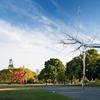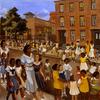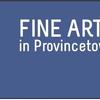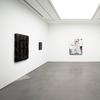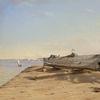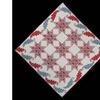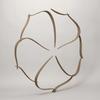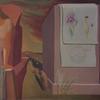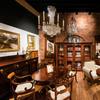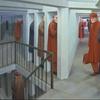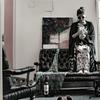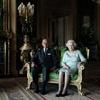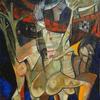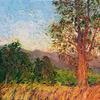Katrín Sigurðardóttir Explores Memory and Transformation in New Exhibition at the MSU Broad
- EAST LANSING, Michigan
- /
- August 20, 2019
The Eli and Edythe Broad Art Museum at Michigan State University (MSU Broad) is set to present Katrín Sigurðardóttir, on view from September 14, 2019–March 1, 2020. Timely and timeless, the work of Sigurðardóttir explores the relationship of memory, distance, and time—an “archaeological” search for meaning, self and social awareness, while confronting the impermanence of all things.
A focused survey of the artist’s past fifteen years of production, the exhibition draws together three major sculptural projects that share a genealogical relationship: Unbuilt Residences (2005–15), Metamorphic (2017–present), and Namesake (2018–present). Collectively, these bodies of work employ various artistic processes of creation and transformation, thus imbuing the works with a sense of resilience and perseverance in their fractured, palimpsestic beauty. This will be the first exhibition to bring these different works together in conversation, expanding and reinforcing their evocative power, while also creating more opportunities for exploration and engagement.
“One of the defining characteristics of Sigurðardóttir’s recent work is the conscious interplay between chance and intention in the creative process, between construction and cataclysm. This working methodology creates a poetic subtext for the objects produced, drawing forth an appreciation for impermanence, vulnerability, and the beautiful yet entropic force of chance transformations,” explains Steven L. Bridges, associate curator at the MSU Broad. “The implications of these (meta)physical processes also relate directly to the context of the exhibition, rooted in Michigan and Midwest, while simultaneously connecting the local with global concerns around the precarity of contemporary life.”
Unbuilt Residences marks the turning point for Sigurðardóttir in the development of her more recent process-based approach. Each of the sculptures is modeled after an architectural plan for a residence in Reykjavík, Iceland, which were never realized. The models are fabricated out of typical model-building materials, but are then destroyed through various means—physical force, fire, gravity—but from the ashes the houses rise again, reconstituted by the artist, returning like persistent memories.
Two more recent series, Metamorphic and Namesake, developed out of her work on the Unbuilt Residences and are ongoing projects. Metamorphic is a body of sculptures based on furniture from a single room in the artist’s childhood home. The 1:1 scale works are initially fabricated out of fragile plaster, and intentionally break during transit. Sigurðardóttir then repairs the sculptures with new, more durable material, and over time the sculptures become increasingly stronger, more durable, and visually akin to metamorphic rocks (e.g. marble). The transit itself is the cataclysmic event that initiates the transformation of the works. As part of Metamorphic, the artist will co-produce a new work with international students from the university. The artist and a small group of collaborators will develop a large-scale floor piece, which will become an immersive 2,500 square foot artwork, sprawling across the main gallery space of the Zaha Hadid-designed building.
For Namesake, Sigurðardóttir mines clay in her native Iceland, molds the clay into cobblestones, and lays them along the banks of the Grand River in Lansing. She will also produce photographs of the cobblestones as objects out of their original and destined locations —a visual referent that sustains, while the physical manifestation disappears, assimilating with its new home. Through this gesture, the artist literally transplants earth from one country to another, while also extending the artwork beyond the museum’s walls and out into the public sphere.
A robust schedule of educational and programmatic efforts accompany the exhibition, further opening up the contents of the show for greater accessibility, but also to allow for other voices and perspectives to be included within.
Katrín Sigurðardóttir is organized by the Eli and Edythe Broad Art Museum at Michigan State University and curated by Steven L. Bridges, Associate Curator. Lead support for this exhibition is provided by the Eli and Edythe Broad endowed exhibitions fund.
Katrín Sigurðardóttir was born in Reykjavik, Iceland. In the last 20 years, her works have been shown extensively in Europe, North and South America and are included in numerous public and private collections. She represented Iceland in the 55th Venice Biennial in 2013, as well as exhibiting in the 33rd Sao Paulo Biennial and FRONT International – Cleveland Triennial for Contemporary Art in 2018, Torino Triennale in 2005 and Momentum Nordic Biennial in 2000. She has had notable solo exhibitions at the MIT List Visual Arts Center, Boston (2015); Parasol Unit Foundation of Contemporary Art, London (2015); SculptureCenter, New York (2014); The Metropolitan Museum of Art, New York (2010); MoMA PS1, New York (2006); FRAC Bourgogne, Dijon, France (2006); Sala Siqueiros, Mexico City (2005); and Fondazione Sandretto, Turin, Italy (2004).
The Eli and Edythe Broad Art Museum at Michigan State University (MSU Broad) is a dynamic contemporary art museum that serves as both a teaching institution and a cultural hub for East Lansing and the region. Opened on November 10, 2012, the museum was designed by Pritzker Prize-winning architect Zaha Hadid and named in honor of Eli and Edythe Broad, longtime supporters of the university who provided the lead gift of $28 million. In 2017, the MSU Broad was awarded $1 million from MSU Federal Credit Union in support of the Art Lab, an expansion across Grand River Avenue that provides increased access to and research of the permanent collection.
Michigan State University has been working to advance the common good in uncommon ways for more than 150 years. One of the top research universities in the world, MSU focuses its vast resources on creating solutions to some of the world’s most pressing challenges, while providing life-changing opportunities to a diverse and inclusive academic community through more than 200 programs of study in 17 degree-granting colleges.


